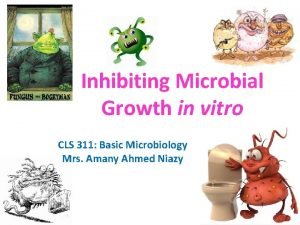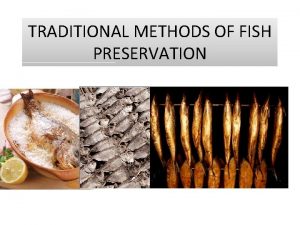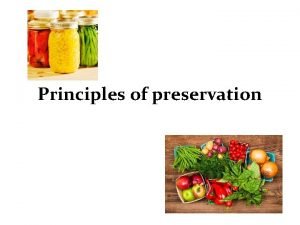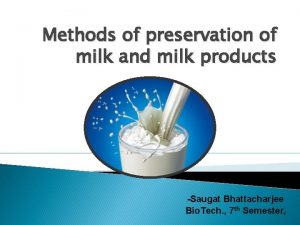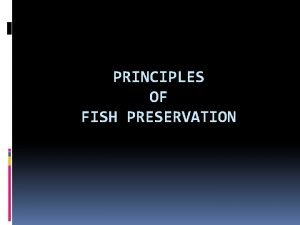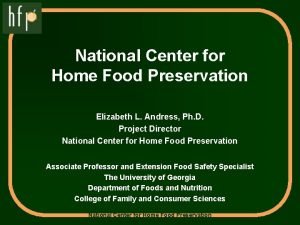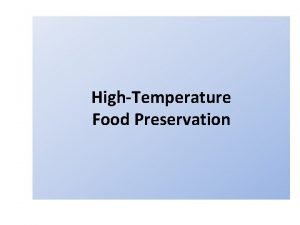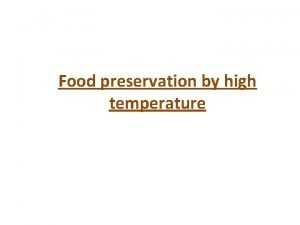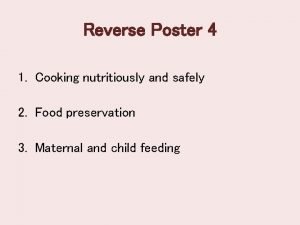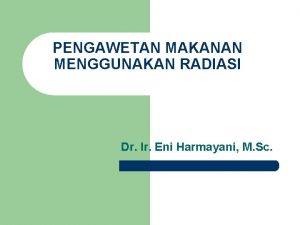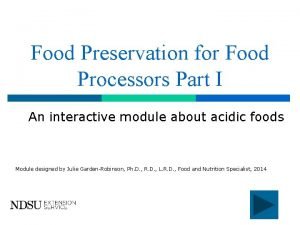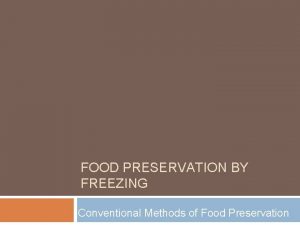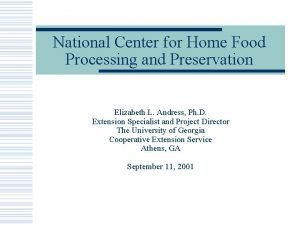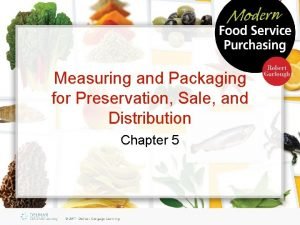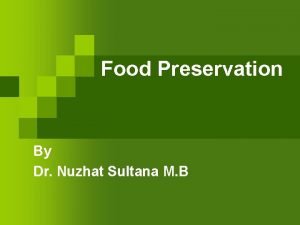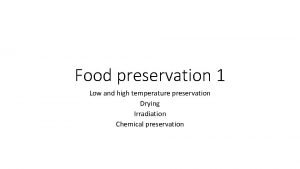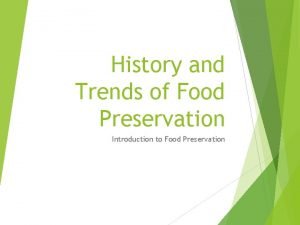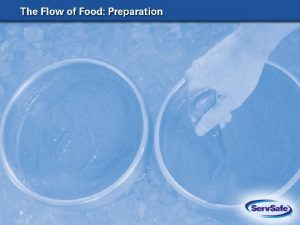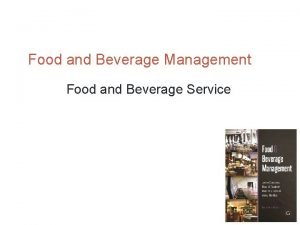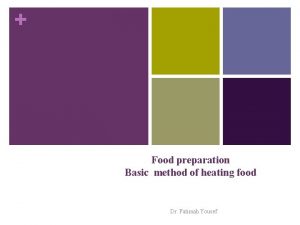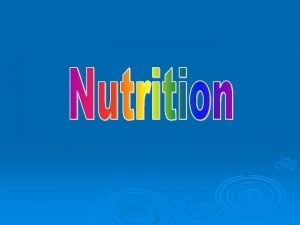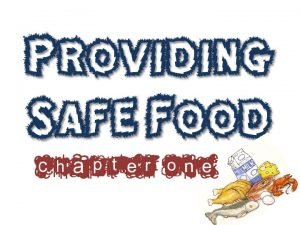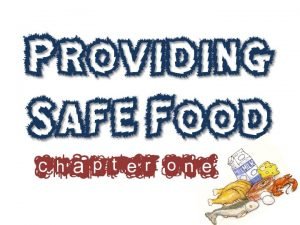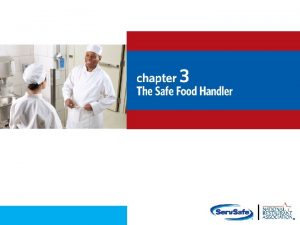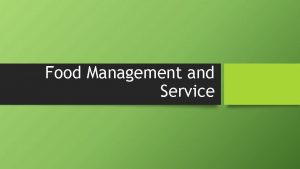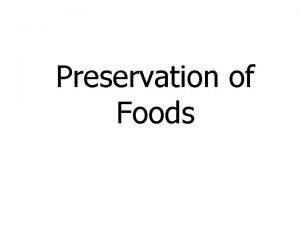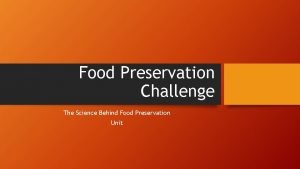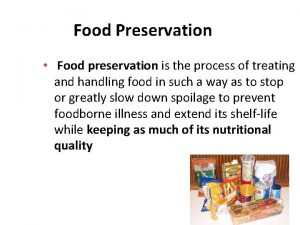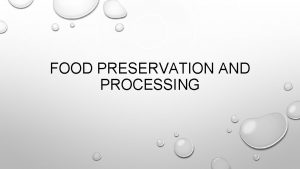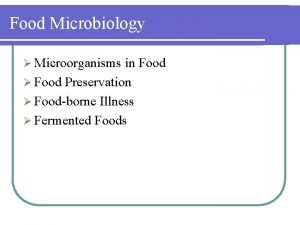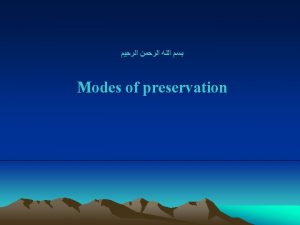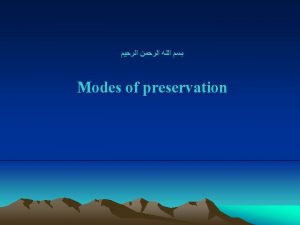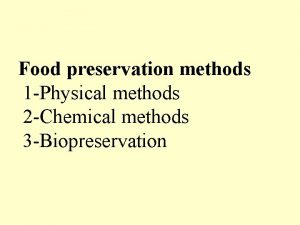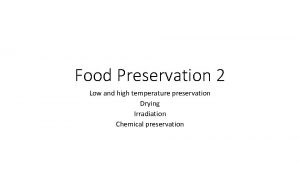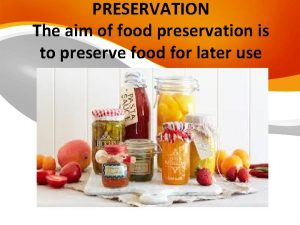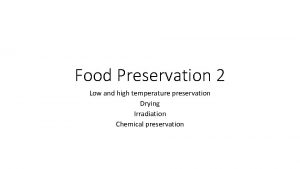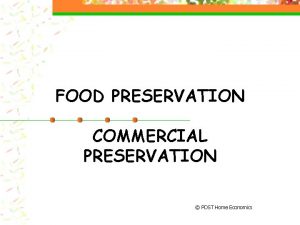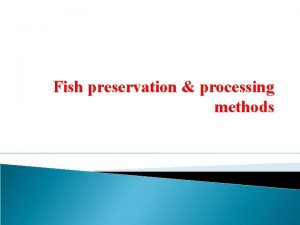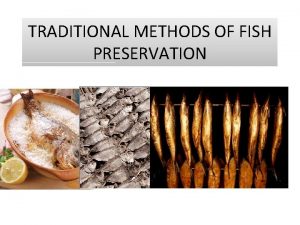Preservation Methods What is food preservation n It






























- Slides: 30

Preservation Methods

What is food preservation? n It is the process of keeping food free of microorganisms that would otherwise cause food spoilage or foodborne illness.

Fermentation n Fermentation is an anaerobic form of cellular respiration in which some bacteria, yeasts and molds obtain energy from sugars without the use of oxygen.

Some Products

Lactic –Acid Bacteria n n Produce lactic acid as a waste product. They are used to produce pickles, sauerkraut, olives, yogurt, sour cream, and some cheeses.

Lactic- Acid Fermentation n Bacteria converts glucose in the food into lactic acid and energy. p. H of the product lowers because acid is being produced, continues until all sugar is used up. p. H goes below 4. 5 other bacteria which normal cause spoilage, will die.

Brine Pickling n n n Pickles are made from cucumbers, brine, and a water/salt mixture. Fermentation takes place until p. H of at least 4. 5 is reached. Vegetables will usually change color slightly and become firm and crisp but tender in texture.

Acetic- Acid Bacteria n n Produces acetic acid as a waste product. They are used in the production of vinegar.

Food Additives used for Preservation n - What are food preservatives? Foods that are treated with chemicals to prevent mold and bacteria from spoiling the food.

Food Additives con’t n n n Food Additives can be both Natural and Synthetic (made in a laboratory) Natural- Ascorbic Acid (Vitamin C) Synthetic – Aspartame (artificial sweetner) - Sodium Nitrate (meat curer, pickling agent)

Uses of Food Additives n n Food preservation can slow down the process that makes fatty foods turn rancid, fruits and vegetables from turning brown, and prevent mold growth Increases storage properties

Uses con’t n Increase Healthfulness - Fortification, add nutrients that are’t normally there. - Restoration, nutrients that are lost in processing are replaced. - Enrichment, adding more nutrients - Nutrification, adds nutrients to increase nutrient/ Calorie ratio.

Other Uses n n Color Flavor Sweetness Processing and Preparation


Concerns n n Long Term Effects - Nitrates and Cancer Food Allergies and Sensitivities Poor Eating Habits Unneeded Additives

Dehydration n Dehydration is the removal of water from foods. - allows food to be stored for longer periods of time without spoilage. -must retain 15 -20% of their water or food will lose color, flavor, texture and nutrient values.

Prevents Bacteria growth n Dehydration of foods limits the bacteria growth on food, as bacteria won’t grow well under moisture levels of 16%.

How is food dehydrated? n n Air circulation and Temperature must be controlled. ( Too high harden food, too low bacteria growth, circulation assists with evaporation) Size, smaller food pieces allow for quick and complete drying.

n - - Pretreatment, some foods must be pretreated with chemicals to prevent spoilage and oxidation. (Fruits) Sulfites, fruits and veggies are soaked in solution to prevent browning. (Metabisulfate, sodium bisulfate) Sulfur, sulfur is burned and creates a coating Sulfur Dioxide on the food. Blanching All methods will slow or prevent enzymatic browning

Questions n n # 1, 2, 5, 6, and 7 Page 434

Freezing and Freeze-Drying n n Freezing- preserves foods by slowing the action of the enzyme rather then destroying them. Microorganisms are not killed, only inactive till thawed.

n Fruit and Vegetables have high water content and because of this they do not freeze well.

n Water molecules will form ice crystals when frozen. Fruits and vegetables have cell walls that are very fragile. During freezing these become damaged and the product loses its shape and texture.

Methods of Freezing in Air - Normal freezing, as in home refrigerators. n

Methods of Freezing Indirect-Contact Freezing - Food is placed on belts of trays, and a refrigerate circulates through a wall beside the food. As food passes by it quickly chills and freezes. - Frozen Vegetables n

Methods of Freezing Immersion Freezing - Food is submerged directly in a nontoxic refrigerate to cause quick freezing. n

Methods of Freezing Freeze-drying - combination of freezing and drying. - Food is frozen then is treated to remove water through sublimation. (Frozen Water to Water vapor) n


Irradiation n n Food is exposed to a controlled amount of radiation for a specific time to destroy organisms that would cause spoilage. Energy is transferred in the form of waves (Gamma Waves) The more waves the food is exposed too, the greater the preservation effect. Relatively new method, because it is radiation there is still concerns

 Physical method of food preservation
Physical method of food preservation Traditional method of fish preservation
Traditional method of fish preservation Heating preservation
Heating preservation Milk preservation methods
Milk preservation methods Fish preservation principles
Fish preservation principles Unit 2 food food food
Unit 2 food food food Grazing food chain diagram
Grazing food chain diagram National center for home food preservation
National center for home food preservation Food preservation by high temperature
Food preservation by high temperature High temperature preservation of food
High temperature preservation of food Food preservation poster
Food preservation poster Microwave food preservation
Microwave food preservation Food preservation definition
Food preservation definition Freezing
Freezing Burial food preservation
Burial food preservation National center for home food preservation
National center for home food preservation Advantages of canning
Advantages of canning Nuzhat sultana
Nuzhat sultana High temperature preservation
High temperature preservation Hurdle technology
Hurdle technology Food preservation history
Food preservation history Direct wax pattern
Direct wax pattern Four acceptable methods of thawing food
Four acceptable methods of thawing food Food and beverage service sequence
Food and beverage service sequence Methods of heating food
Methods of heating food Food scientist measure food energy in
Food scientist measure food energy in Tcs stands for food
Tcs stands for food Tcs food
Tcs food A little food or a few food
A little food or a few food Primary secondary tertiary food chain
Primary secondary tertiary food chain Food handlers can contaminate food when they answer
Food handlers can contaminate food when they answer
